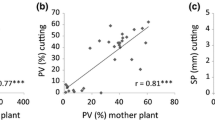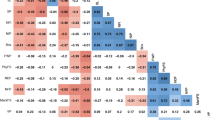Abstract
Plants in tropical regions experience temperature fluctuation only in non-extreme ambient temperatures. Thus, moderate changes in temperatures, which they never experience in their local environments, might be sufficient to manifest the locally hidden phenotype caused by natural mutation. To validate this hypothesis, temperature-treating experiments were performed on Capsicum accessions collected from tropical regions. Thirty-six Capsicum accessions, collected from Caribbean countries, were screened for temperature sensitivity. Similarities in their temperature sensitivities were compared with Sy-2 (C. chinense) from Seychelles, which was previously found to be a temperature-sensitive accession. Tr-13 from Trinidad & Tobago exhibited developmental abnormalities at temperatures below 24 °C. Expression of defense-related genes was induced, and salicylic acid, which is a key molecule in the plant’s defense response, accumulated in Tr-13 at temperatures below 24 °C. Tr-13 and Sy-2 appeared normal when they were grown at temperatures simulating those in Trinidad and Seychelles, respectively. Crossing Tr-13 with No. 3341 or Sy-2 revealed that the temperature-sensitive phenotype of Tr-13 was caused by a genetic mutation in the same locus as Sy-2. Plants having a temperature-sensitive phenotype that is caused by natural mutations evade artificial selection and exist as crops in specific environments, such as tropical regions.








Similar content being viewed by others
References
Akamatsu T, Hanzawa Y, Ohtake Y, Takahashi T, Nishitani K, Komeda Y (1999) Expression of endoxyloglucan transferase genes in acaulis mutants of Arabidopsis. Plant Physiol 121:715–721
Andrews J (1995) Peppers: the domesticated Capsicums, 2nd edn. University of Texas Press, Austin
Bosland PW, Votava EJ (2000) Peppers: vegetable and spice capsicums. CABI Publishing, Oxfordshire
Heil M, Baldwin IT (2002) Fitness costs of induced resistance: emerging experimental support for a slippery concept. Trends Plant Sci 7:61–67
Hua J, Grisafi P, Cheng SH, Fink GR (2001) Plant growth homeostasis is controlled by the Arabidopsis BON1 and BAP1 genes. Genes Dev 15:2263–2272
Ince AG, Karaca M, Onus AN (2010) Polymorphic microsatellite markers transferable across Capsicum species. Plant Mol Biol Rep 28:285–291
Kim YC, Kim SY, Paek KH, Choi D, Park JM (2006) Suppression of CaCYP1, a novel cytochrome P450 gene, compromises the basal pathogen defense response of pepper plants. Biochem Biophys Res Commun 345:638–645
Koeda S, Hosokawa M, Kang BC, Yazawa S (2009) Dramatic changes in leaf development of the native Capsicum chinense from the Seychelles at temperatures below 24°C. J Plant Res 122:623–631
Koeda S, Takezaki A, Isomura Y, Yazawa S (2010) Developmental abnormality of a local pepper cultivar (Capsicum chinense) from the Seychelles below 24°C. Bulletin Exp Farm Kyoto University 19:15–20 (Abstract in English, Text in Japanese)
Koeda S, Hosokawa M, Kang BC et al (2012) Defense response of a pepper cultivar cv. Sy-2 is induced at temperatures below 24°C. J Plant Res 125:137–145
Lee JM, Nahm SH, Kim YM, Kim BD (2004) Characterization and molecular genetic mapping of microsatellite loci in pepper. Theor Appl Genet 108:619–627
Meisel L, Xie S, Lam E (1996) lem7, a novel temperature-sensitive Arabidopsis mutation that reversibly inhibits vegetative development. Dev Biol 179:116–134
Nei M, Tajima F, Tateno Y (1983) Accuracy of estimated phylogenetic trees from molecular data. J Mol Evol 19:153–170
Nonnecke LL (1989) Vegetable production. Van Nostrand Reinhold, New York
Pickersgill B (1969) The archaeological record of chilli peppers (Capsicum spp.) and the sequence of plant domestication in Peru. Am Antiq 34:54–61
Pitzschke A, Schikora A, Hirt H (2009) MAPK cascade signalling networks in plant defence. Curr Opin Plant Biol 4:421–426
Queitsch C, Sangstert TA, Lindquist S (2002) Hsp90 as a capacitor of phenotypic variation. Nature 417:618–624
Rutherford SL, Lindquist S (1998) Hsp90 as a capacitor for morphological evolution. Nature 396:336–342
Saitou N, Nei M (1987) The neighbor-joining method: a new method for reconstructing phylogenetic trees. Mol Biol Evol 4:406–425
Samuelsen AI, Rickson FR, Mok DWS, Mok MC (1997) A temperature-dependent morphological mutant of tobacco. Planta 201:303–310
Sangster TA, Salathia N, Lee HN, Watanabe E, Schellenberg K, Morneau K, Wang H, Undurraga S, Queitsch C, Lindquist S (2008) HSP90-buffered genetic variation is common in Arabidopsis thaliana. Proc Natl Acad Sci USA 105:2963–2968
Shirasawa K, Ishii K, Kim C, Ban T, Suzuki M, Ito T, Muranaka T, Kobayashi M, Nagata N, Isobe S, Tabata S (2012) Development of Capsicum EST-SSR markers for species identification and in silico mapping onto the tomato genome sequence. Mol Breed 31:101–110
Singh RJ (2007) Genetic resources, chromosome engineering, and crop improvement, vol 3. Taylor and Francis/CRC Press, Boca Raton
Sureshkumar S, Todesco M, Schneeberger K, Harilal R, Balasubramanian S, Weigel D (2009) A genetic defect caused by a triplet repeat expansion in Arabidopsis thaliana. Science 323:1060–1063
Takezaki N, Nei M, Tamura K (2010) POPTREE2: software for constructing population trees from allele frequency data and computing other population statistics with windows interface. Mol Biol Evol 27:747–752
Tsukaya H, Inaba-Higano K, Komeda Y (1995) Phenotypic characterization and molecular mapping of an acaulis2 mutant of Arabidopsis thaliana with flower stalks of much reduced length. Plant Cell Physiol 36:239–244
Verberne MC, Brouwer N, Delbianco F, Linthorst HJM, Bol JF, Verpoorte R (2002) Method for the extraction of the volatile compound salicylic acid from tobacco leaf material. Phytochem Anal 13:45–50
Waites R, Hudson A (1995) Phantastica: a gene required for dorsoventrality of leaves in Antirrhinum majus. Development 121:2143–2154
Yi G, Lee JM, Lee S, Choi D, Kim BD (2006) Exploitation of pepper EST-SSRs and an SSR-based linkage map. Theor Appl Genet 114:113–130
Acknowledgments
We thank the Caribbean Agricultural Research and Development Institute for providing the accessions from their germplasm. We also thank anonymous reviewers for their kind suggestions and comments on the revision of the manuscript. This work was supported by a Grant-in-Aid for Scientific Research [22405017] from the Japan Society for the Promotion of Science.
Author information
Authors and Affiliations
Corresponding author
Rights and permissions
About this article
Cite this article
Koeda, S., Hosokawa, M., Saito, H. et al. Temperature-sensitive phenotype caused by natural mutation in Capsicum latescent in two tropical regions. J Plant Res 126, 675–684 (2013). https://doi.org/10.1007/s10265-013-0564-4
Received:
Accepted:
Published:
Issue Date:
DOI: https://doi.org/10.1007/s10265-013-0564-4




